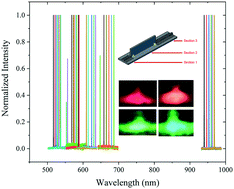Single mode operation and ultrawide tuning of on-chip optofluidic dye lasers
Abstract
Single transverse mode lasers that can be continuously tuned over ultrawide wavelength ranges with a narrow linewidth are very important components for lab-on-a-chip systems. Such lasers that can be tuned over the whole visible spectrum or even beyond have not been demonstrated hitherto regardless of many years of research in this area. This article presents an on-chip optofluidic distributed Bragg reflector (DBR) dye laser constituted by a combination of a T-shaped optofluidic waveguide (T waveguide) and two ridge-waveguide-based fluidic DBR gratings, in which the T waveguide provides gain for lasing and the DBR gratings select the lasing wavelength. This configuration guarantees that the fundamental mode has a much lower loss (consequently much lower lasing threshold) than all the higher order modes. By fabricating PDMS devices of such structure and changing the fluid in DBR gratings as well as the gain fluid in the T waveguide, we demonstrate a single mode optofluidic dye laser that can be continuously tuned over a wavelength range of more than 450 nm with a linewidth less than 0.1 nm. Mode patterns obtained when using different laser dyes in the T waveguide verify fundamental mode operation over the wide wavelength range.



 Please wait while we load your content...
Please wait while we load your content...